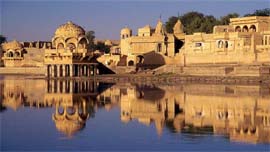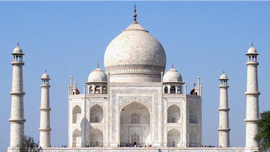
Taj Mahal - Agra, Uttar Pradesh
Taj Mahal, the pinnacle of Mughal architecture, was built by the Mughal emperor Shah Jahan (1628-1658), grandson of Akbar the great, in the memory of his queen Arjumand Bano Begum, entitled 'Mumtaz Mahal'. Mumtaz Mahal was a niece of empress Nur Jahan and granddaughter of Mirza Ghias Beg I'timad-ud-Daula, wazir of emperor Jehangir. The Taj Mahal is the mausoleum of both Mumtaz Mahal and Shah Jahan.
The mausoleum is located on the right bank of the river Yamuna at a point where it takes a sharp turn and flows eastwards. For construction, a network of wells was laid along the river line to support the huge mausoleum buildings. Masons, stonecutters, inlayers, carvers, painters, calligraphers, dome-builders and other artisans were requisitioned from the whole of the empire and also from Central Asia and Iran. While bricks for internal constructions were locally prepared, white marble for external use in veneering work was obtained from Makrana in Rajasthan.
Khajuraho temples - Madhya Pradesh
Right through the Mughal invasion and the early British forays into India, Khajuraho temples in India remained unknown. Rediscovered in this century, they are fine reminders of India's glorious past.
To some, Khajuraho Temples are the most graphic, erotic and sensuous sculptures of India, the world has ever known. But Khajuraho has not received the attention it deserves for its significant contribution to the religious art of India - there are literally hundreds of exquisite images on the interior and exterior walls of the shrines. Architecturally these temples are unique. While each temple in Khajuraho has a distinct plan and design, several features are common to all. They are all built on high platforms, several metres off the ground, either in granite or a combination of light sandstone and granite. Each of these temples has an entrance hall or mandapa, and a sanctum sanctorum or garbha griha.
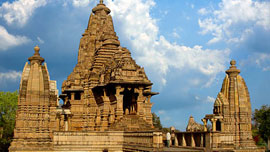
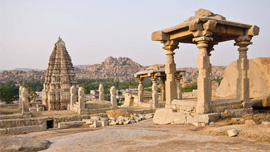
Historical Ruins - Hampi, Karnataka
Once the majestic capital of the powerful Vijayanagara Empire, Hampi is now a ruined city of ancient palaces and forts. Founded by Harihara and Bukka in 1336, the landscape of Hampi was dotted with magnificent palaces, sacred temples, massive fortifications, baths, markets, pavilions, and stables for royal elephants. The Vijayanagara kings were great patrons of art and Hampi became the epicenter of a flourishing indigenous culture.
The majestic Virupaksha temple stands proudly amidst the ruins of Hampi. While the city of Hampi was pillaged by marauding invaders, the Virupaksha temple stood erect and worship continued throughout the ages. The deity of Virupaksheshwara or Pampapathi, an incarnation of Lord Shiva, is worshipped here.
Mysore Palace - Mysore, Karnataka
The Mysore Palace, built is Indo-Saracenic style with domes turrets, arches and colonnades, the palace is a treasure house of exquisite carvings and works of art from all over the world. The tastefully decorated and inticrately carved doors open into luxuriously decorated rooms.
The walls of the palace are painted with pictures of the Dassera processions and these paintings are painted in such a manner that from any angle you can see the procession coming towards you. The royal throne of the Wodeyars is displayed during the Dassera festival.
The palace has now been converted into a museum, which treasures the souvenirs, paintings, jewellery, royal costumes and other items, which were once possessed by the Wodeyars. It is said that the palace displays the largest collection of gold items, quantity wise. The Durbar hall of the palace has an ornate ceiling and many sculpture pillars which are said to have been painted with gold.
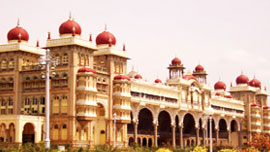

Crawford Market - Kalbadevi, Mumbai
Mumbai/Bombay offers an exciting shopping experience for all those who love to splurge. Among the most vibrant markets in the city that jostles with life and enthusiasm, is Crawford market situated on the North of Victoria terminus in South Mumbai. Crawford market is famous for its wholesale fruits, fresh vegetables and poultry market.
Built in 1871, Crawford market is also known as Jyotiba Phule Market and more than just a wholesale market dealing with food items. You can marvel the grand architecture of this covered market that has a striking colonial imprint to it. The market is nestled between the British fort and the local town. Depicting a fusion of both Flemish and Norman architecture, Crawford market has a bas relief portraying Indian peasants in wheat field just above the main entrance.
Humayun's Tomb - Delhi
Humayun died in 1556, and his widow Hamida Banu Begam, also known as Haji Begam, commenced the construction of his tomb in 1569, fourteen years after his death. It is the first distinct example of proper Mughal style, which was inspired by Persian architecture. It is well known that Humayun picked up the principles of Persian architecture during his exile, and he himself is likely to have planned the tomb, although there is no record to that effect. The tomb was constructed at a cost of 15 lakh rupees (1.5 million).
The tomb proper stands in the centre of a square garden, divided into four main parterres by causeways (charbagh), in the centre of which ran shallow water-channels. The high rubble built enclosure is entered through two lofty double-storeyed gateways on the west and south. A baradari (pavilion) occupies the centre of the eastern wall and a hammam (bath chamber) in the centre of northern wall.
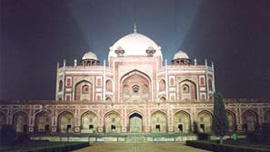
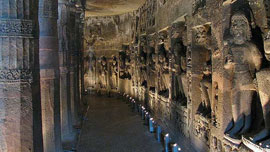
Ajanta Caves - Near Aurangabad / Jalgaon
A viewing platform across the Waghora River provides an excellent view of Ajanta Caves. The area is beautiful and this was why the Buddhist monks chose this site for their spiritual pursuits. They used the caves as prayer halls and monasteries for nine centuries. Thus these caves that were excavated around 200 BC were abruptly abandoned and fell into oblivion in 650 AD in favor of Ellora, until they were rediscovered by a British tiger-hunting party in 1819.
Some British soldiers were out hunting in the Deccan Plateau, and one of them saw a horseshoe rock from a height. The cave's entrance increased his curiosity and thus the hunting party ventured across the ravine of the Waghur River. They discovered the caves against which were bush, earth, shrubs and stones. They informed the Government about their finding and the archaeologists began to excavate them.
Jaisalmer Fort - Jaisalmer, Rajasthan
Jaisalmer Fort is a monument worth visiting and worth retaining in your conscious mind. Like various other cities of Rajasthan, in Jaisalmer too you will find different facets of its own glorious heritage. Though you can find historical monuments scattered all over the city, the Jaisalmer Fort will immediately command your attention. Made of sand stones and locally known as Sonar Quila, the Jaisalmer Fort is a dominating structure amidst sands.
The city is said to be founded by one Raja Rawal Jaisal, a Bhatti Rajput ruler, in approximately 1156 A D. Legends go by that he did it on the behest of a local hermit named Eesaal. The raja choose Trikuta hill as the new site for his fort as his earlier adobe at Luderwa(16 k.m from present Jaisalmer) was too vulnerable to his comfort. But it should always be kept in mind that these legends are most of the time product of conscious minds that are very vulnerable to the oriental exaggeration.
